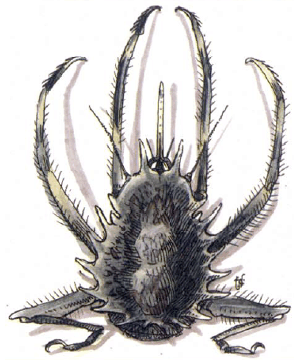

Monstrous Compendium Annual, Volume One

| Climate/Terrain: | Temperate to tropical urban and subterranean |
|---|---|
| Frequency: | Very rare |
| Organization: | Solitary |
| Activity Cycle: | Night |
| Diet: | Blood |
| Intelligence: | Non- (0) |
| Treasure: | Nil |
| Alignment: | Neutral |
| No. Appearing: | 1d4 |
| Armor Class: | 5 |
| Movement: | 6, leap 21 |
| Hit Dice: | 1 |
| THAC0: | 20 |
| No. of Attacks: | 4 or 1 |
| Damage/Attack: | 1d2 (×4) or 1 point per round |
| Special Attacks: | Egg laying |
| Special Defenses: | Nil |
| Magic Resistance: | Nil |
| Size: | T (6” diameter) |
| Morale: | Average (8-10) |
| XP Value: | 65 |
There are few creatures more horrid than the heart tick. Thankfully very rare, these terrible parasites feed on the blood of humans and demihumans.
Heart ticks are roughly circular in shape, averaging 6 inches in diameter and bringing to mind horseshoe crabs or beetles. Their tough exoskeleton ranges in color from dark gray to black. They have no eyes and are wholly blind, making use of their excellent hearing to hunt prey. The heart tick has six legs, four of them designed to grip prey and two made for leaping.
Heart ticks are utterly unintelligent and have no language. They are known to emit clicks and chirps, but fall silent when prey draws near.
Combat: So delicate is the heart tick’s ability to detect sounds that it can hear the heart beat of an approaching human, demihuman, or humanoid when he is still 50 feet away. Indeed, the heart tick can even tell if the creature’s heartbeat is muffled by armor (it will not attack anyone in metal armor).
When an acceptable target comes within range, the heart tick leaps. This imposes a -3 penalty upon the victim’s surprise roll. On the round that it leaps, the heart tick gains a +2 bonus to its attack roll. If the victim is surprised, this bonus increases to +4.
The heart tick attacks four times by driving its four barbed legs into its victim’s flesh. In addition to inflicting 1-2 points of damage, a successful hit allows the parasite to anchor itself to its prey. If all four attacks fail, the heart tick has missed its mark and must spend two rounds positioning itself for another leap before it can attack again. Once a heart tick sinks a leg into its victim, it will not use that limb to attack again. Legs that failed to hit on previous rounds will attack each round until they have anchored the parasite to its host.
Once a heart tick has secured itself to a victim with all four legs, it attempts to plunge its feeding tube into his flesh. No roll is required for this attack and the victim promptly suffers 1 point of damage as the creature feeds upon his blood. On each subsequent turn, an additional point is lost. When the heart tick has drained a number of points equal to its own starting hit points, it is sated. At this point it yanks out its legs, inflicting an additional 1d2 points of damage each, and drops to the ground.
Removing a heart tick from a victim before it has finished feeding is a difficult task. Anyone determined to do so must attempt a bend bars/lift gates roll. For each leg that has buried itself in the victim’s body, a 1% penalty is applied to this roll. Each leg pulled out of the body inflicts 1d2 points of damage. Even if the creature is killed, the legs that it had buried in its victim must still be removed. Pulling these out requires a successful Strength check and causes 1d2 points of damage each.
Attacking a heart tick while it is secured to someone requires a great deal of care. Area attacks will inflict full damage upon both the tick and its host, while other attacks will cause half damage to both parties. Called shots might be possible to damage only the tick and not the host, although this will depend upon the exact situation.
Habitat/Society: The origin of heart ticks is unknown, but they are believed to have arrived from distant lands in the holds of ships.
Ecology: Like all parasites, heart ticks cannot exist without a host to feed upon. Unfortunately, the chosen food of these vile creatures is mankind. Anyone who dies from the feeding of a heart tick will be injected with its eggs. In one week, 2d4 heart ticks will emerge from the body, and begin to seek food.
